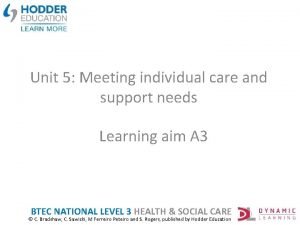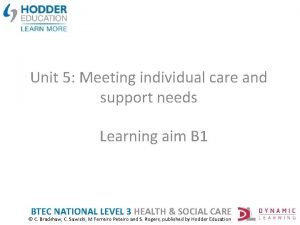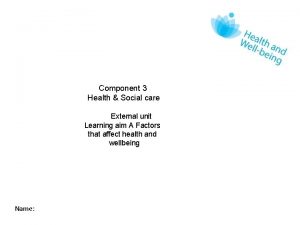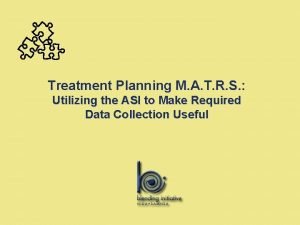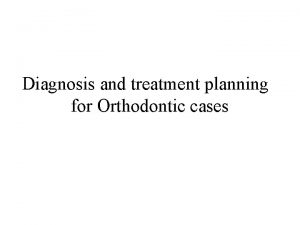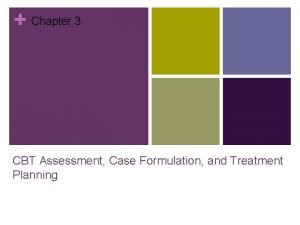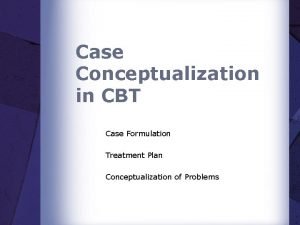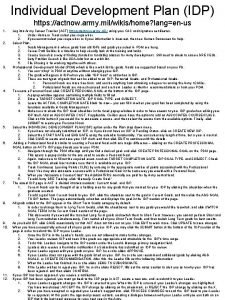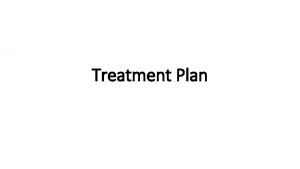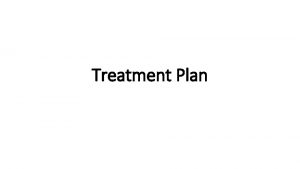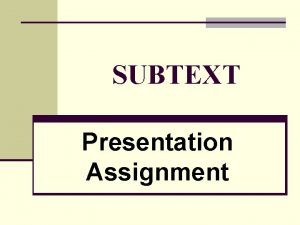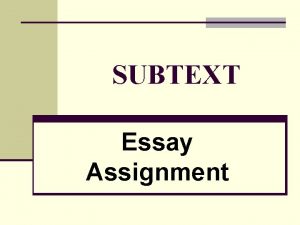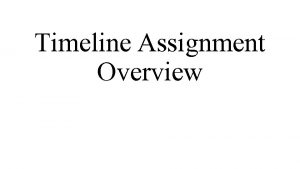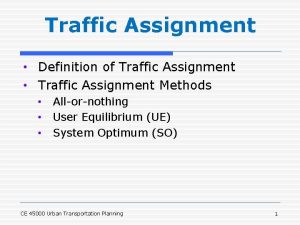Assignment 2 Learning Aim D Individual Treatment Plan

































- Slides: 33

Assignment 2 Learning Aim D: Individual Treatment Plan Unit 14 Physiological disorders and their care

Assignment 2 criteria P 5 Assess care needs of a selected service user with a physiological disorder. P 6 Plan treatment to meet the needs of a selected service user with a physiological disorder. P 7 Explain how the plan would improve the health and wellbeing of a selected service user. M 4 Plan treatment to meet the needs of a selected service user with a physiological disorder, reviewing as appropriate to improve outcomes. D 3 Justify the recommendations in the plan in relation to the needs of the service user and advantages and disadvantages of treatment options.

P 5 Assessing Care Needs 1. Care Planning Cycle? 2. Background 3. Individual Needs – e. g. Age 4. Local Authority Care Needs Assessment – 10 Eligibility Criteria and outcome 5. Full Care Needs assessment – use the booklet 6. Most important Care Need to the patient? 7. Patient’s Aims for the Treatment plan

Local Authority Care Needs Assessment • A Local Authority Care Needs Assessment is for service users aged 18 and over only. • If your case study is under 18 this will not be relevant. Please delete the table from the Treatment Plan template. • However, we do need to mention it in our coursework – a short paragraph will be enough: • “As ____ is under 18, a Local Authority Care Needs Assessment would not be appropriate, however their carers _____ may be entitled to a Carer’s Assessment. This would involve…. ”

Full Care Needs Assessment Needs Care needs Physical symptoms to be reduced or cured e. g. pain, swelling, tenderness etc. Mobility issues impacting on ability to get around the house or out to work / the shops Intellectual Lack of knowledge about their disorder Missing work / school / college Poor concentration / restlessness Depression Anxiety Denial Fear Lack of trust Needs diagnosis and peace of mind Bullying Sense of self – linked to work or volunteering or “keeping busy” Lack of social contact Social anxiety Social exclusion Fear of contamination / infection Loss of friends Loss of independence Emotional Social Do a minimum of 5 Care Needs, making sure you cover each of P. I. E. S.

P 6 Planning Treatment and Care 8. 9. Levels of service in the NHS (Assignment) Overall Aims of the Treatment Plan from Point Of View of Assessor (Assignment) 10. Treatments and Care Strategies table (Treatment Plan Template)

8. Levels of service in the NHS (Assignment) • Primary, Secondary and Tertiary • Explain each one and give examples relevant to your case study

9. Overall Aims of the Treatment Plan from Point Of View of Assessor Write a short paragraph explaining the Overall aims of the Treatment plan: • stabilise the disorder by… / cure the disorder by… • empowerment and involvement of the patient • multi-disciplinary team working • individualised care - what will the patient want? Or not want?

10. Treatments and Care Strategies table (Treatment Plan Template) • Copy and paste your Care Needs Assessment into the template. • Complete the Treatments and Care Strategies section on the Individual Treatment Plan Template. • Find a Minimum OF two treatments or care strategies which will resolve each Care Need.

10. Treatments and Care Strategies table (Treatment Plan Template) • Identify each strategy as primary, secondary or tertiary care OR voluntary or private sector and explain which professional would support the patient as well as the setting for each one. Be LOCAL and specific.

10. Treatments and Care Strategies table (Treatment Plan Template) • In the table, summarise the advantages and disadvantages/limitations of each strategy for the patient. • How do they meet the needs of the person? • How do they help to achieve the outcomes the patient desires?

Consider… • How does it help the patient relieve their symptoms or assist them in overcoming their issues with the disorder? • Effectiveness, cost etc. • The personal circumstances of the patient’s life. • The patient’s age, gender, ethnicity, marital status etc. • Remember - the care planning process is about EMPOWERMENT – you and the patient should agree on the set of strategies to use. • What would the patient want?

Assignment 2 criteria P 5 Assess care needs of a selected service user with a physiological disorder. P 6 Plan treatment to meet the needs of a selected service user with a physiological disorder. P 7 Explain how the plan would improve the health and wellbeing of a selected service user. M 4 Plan treatment to meet the needs of a selected service user with a physiological disorder, reviewing as appropriate to improve outcomes. D 3 Justify the recommendations in the plan in relation to the needs of the service user and advantages and disadvantages of treatment options.

P 7: 11. Which is the most beneficial treatment or care strategy for the patient? (Assignment LA D) • Why do you think these are the best treatments for the patient? Give EVIDENCE to support your answer. • How will they resolve the patient’s Care Needs?

12. Professional responsibilities of staff (Assignment LA D) • Promoting anti-discriminatory practice • Empowering individuals • Ensuring safety • Confidentiality and communication • Accountability to professional bodies • Multi-disciplinary working

Assignment 2 criteria P 5 Assess care needs of a selected service user with a physiological disorder. P 6 Plan treatment to meet the needs of a selected service user with a physiological disorder. P 7 Explain how the plan would improve the health and wellbeing of a selected service user. M 4 Plan treatment to meet the needs of a selected service user with a physiological disorder, reviewing as appropriate to improve outcomes. D 3 Justify the recommendations in the plan in relation to the needs of the service user and advantages and disadvantages of treatment options.

13. Possible barriers to care and how they can be overcome (Assignment LA D) • What are the potential barriers that might prevent the patient from completing the treatment or strategy? • Consider their age and other individual needs. • Consider P. I. E. S. S. • How could these barriers be overcome?

14. Treatment Plan Review Date (Treatment Plan Template) • At the end of the Care Needs Assessment log the review dates going forward.

15. Care Plan Review (Treatment Plan Template) First you must decide WHEN the review is taking place, this must be after a reasonable period of time during which a change might happen: • Initial review – between one and six months after diagnosis: this would be where treatment is refined. • Or a point much later in a patient’s life

15. Care Plan Review (Treatment Plan Template) Choose at least ONE change that could have happened in this time. For example: • Is Vijay’s cancer treatable or will he need palliative care? • Will Meera adapt to injections four times a day or will she need an insulin pump? • Will Rose need a mobility aid? • Can Rex’s Parkinson’s symptoms be managed at home?

15. Care Plan Review (Treatment Plan Template) Consider the point of view of the patient first: • What might have happened in that time? • Nature of the disorder, home life, hobbies, careers, friends, family etc. • Do you think the care plan is working? • Why or why not? Then consider the thoughts of the GP: • What are the alternatives to the strategies you agreed in the original plan?

Assignment 2 criteria P 5 Assess care needs of a selected service user with a physiological disorder. P 6 Plan treatment to meet the needs of a selected service user with a physiological disorder. P 7 Explain how the plan would improve the health and wellbeing of a selected service user. M 4 Plan treatment to meet the needs of a selected service user with a physiological disorder, reviewing as appropriate to improve outcomes. D 3 Justify the recommendations in the plan in relation to the needs of the service user and advantages and disadvantages of treatment options.

16. Treatments and Care Strategies with Advantages and Disadvantages (Treatment Plan Template) • Check you have done enough detail on the advantages and disadvantages in number 10.

17. Reliability and validity of two sources of information (Treatment Plan Template) • Choose ONE Care strategy and give a general definition for reliability and validity. • Find TWO sources of evidence to support the use of that Care Strategy with your patient. • For each source, complete the Reliability and Validity table on the Treatment Plan Template.

17. Reliability and validity of two sources of information (Treatment Plan Template) • For the “Origin of the source”; is it a peer reviewed scientific journal, blog page, charity website? • For the “Author or organisation”; are they well-qualified to talk about the topic? Do they have a good reputation in that field? Are they independent with no bias? • For “What evidence is presented to support the points made”; quote the information that supports your points. • To what extent do you trust this source to give reliable and unbiased information? Use the WAGOLL as an example.

18. Justification of the Treatment plan (Assignment LA D) • How will the Treatment Plan meet the individual care and support needs and wishes of the patient and his/her family? • Link this back to the outcomes the patient raised in the Care Needs Assessment. • How will it impact the Health and Wellbeing of the patient? • Discuss each of P. I. E. S. • How will the plan help to achieve the Overall aims of the Treatment Plan?

19. Reviewing the Treatment Plan (Assignment LA D) Why is it important to do a Care plan review? • The Treatment Plan considers the patient when they are first diagnosed. As the patient continues on this plan over months, or even years, circumstances may change that will influence the disorder and how effective the treatments or care strategies may be.

19. Reviewing the Treatment Plan (Assignment LA D) The symptoms of the disorder may improve (because the treatment is working). The symptoms of the disorder may get worse (because the disorder is progressive and / or the treatment is not effective). New symptoms may develop as the disorder progresses.

19. Reviewing the Treatment Plan (Assignment LA D) There may be changes in the patient’s life, for example: • losing or gaining employment • the death or relocation of a family member who might have been a carer for the patient Long waiting lists to see a specialist consultant or for surgery may have delayed treatment

19. Reviewing the Treatment Plan (Assignment LA D) Surgical operations may be repeatedly cancelled as urgent cases take priority Transport to appointment may be an issue and service user may have missed them The care strategies are not working as effectively as they should. The medication may have side effects that the patient in not happy with.

20. Justification of the Care Plan Review (Assignment LA D) Choose ONE CHANGE you have suggested and write a short paragraph to explain why you recommend that care strategy: • How will this new strategy help the patient? • How does it compare to the other available options (if any)? • Why is this strategy better for the patient - because of their lifestyle or the current stage of their disorder?

20. Justification of the Care Plan Review (Assignment LA D) To support your reasons, include at least one source of evidence from a reliable source. How would these changes improve the Health and Wellbeing of the patient? Include each P. I. E. S. How does this change enable the patient to achieve the Original Overall Aims of the Treatment Plan?

Bibliography (Assignment LA D) Highlight your evidence in your work by stating your source in brackets as you go along: • (NHS website) Bibliography: include all your sources of information: • Website url link • Title of article • Name of website or organisation • Date accessed
 Unit 5 meeting individual care and support needs
Unit 5 meeting individual care and support needs Unit 5 meeting individual care and support needs
Unit 5 meeting individual care and support needs Cuadro comparativo e-learning y b-learning
Cuadro comparativo e-learning y b-learning Unit 5 health and social care coursework example p3
Unit 5 health and social care coursework example p3 Learning aim c btec business
Learning aim c btec business Unit 14 learning aim d
Unit 14 learning aim d Health and social care unit 14 learning aim d
Health and social care unit 14 learning aim d Health and social care component 2 learning aim b example
Health and social care component 2 learning aim b example Learning targets helping students aim for understanding
Learning targets helping students aim for understanding Learning aim d health and social care
Learning aim d health and social care Treatment plan problem statement examples
Treatment plan problem statement examples Social work treatment plan example
Social work treatment plan example Diarrhea treatment plan a b c
Diarrhea treatment plan a b c Reality therapy
Reality therapy Class iii
Class iii Lip length classification
Lip length classification Treatment plan goals and objectives for adhd
Treatment plan goals and objectives for adhd Gottman treatment plan example
Gottman treatment plan example Cbt problem list example
Cbt problem list example Ro dbt diary card
Ro dbt diary card Asi treatment plan example
Asi treatment plan example Case conceptualization cbt example
Case conceptualization cbt example Compliance with treatment plan
Compliance with treatment plan Iop treatment plan sample
Iop treatment plan sample Sud treatment plan
Sud treatment plan Chapter 13 medical math
Chapter 13 medical math Dr teresita go
Dr teresita go Individual differences factors
Individual differences factors 10 year plan assignment
10 year plan assignment E commerce business plan assignment
E commerce business plan assignment Plan de desarrollo individual ejemplos
Plan de desarrollo individual ejemplos Individual work plan
Individual work plan Individual service plans
Individual service plans Army actnow
Army actnow
